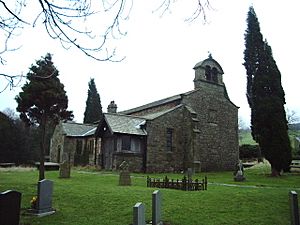St Chad's Church, Claughton facts for kids
Quick facts for kids St Chad's Church, Claughton |
|
|---|---|

St Chad's Church, Claughton, from the northwest
|
|
| Lua error in Module:Location_map at line 420: attempt to index field 'wikibase' (a nil value). | |
| OS grid reference | SD 567,666 |
| Location | Claughton, Lancashire |
| Country | England |
| Denomination | Anglican |
| History | |
| Status | Former parish church |
| Founded | 1070 |
| Dedication | Saint Chad |
| Architecture | |
| Functional status | Redundant |
| Heritage designation | Grade II |
| Designated | 4 December 1985 |
| Architect(s) | Austin and Paley (restoration and additions of 1904) |
| Architectural type | Church |
| Style | Gothic, Gothic Revival |
| Completed | 1904 |
| Specifications | |
| Length | 50 feet (15 m) |
| Width | 26 feet (8 m) |
| Materials | Sandstone, slate roof |
St Chad's Church is a historic building located in the village of Claughton, Lancashire, England. It used to be an Anglican parish church, but it is no longer used for regular services. This church is officially recognized as a Grade II listed building, which means it is an important historical structure.
Contents
A Look at St Chad's Church History
The very first church on this spot was built way back in 1070. We even have records of its rectors (the priests in charge) going all the way back to 1230. The church building you see today was constructed on the same site in 1815.
Changes and Updates Over Time
In 1869, an architect named Hubert Austin designed new tracery for the east window. Tracery is the decorative stonework that holds the glass in place. This work cost about £270. The new window also featured beautiful stained glass designed by Henry Holiday.
More big changes happened in 1904. The famous architectural firm Austin and Paley worked on the church. They added a north aisle (a side part of the church) and a porch. They also added buttresses, which are supports on the outside walls. Inside, they replaced the floor and removed the old plaster ceiling. New seating, a pulpit (where the sermon is given), and a lectern (a stand for reading) were also added. This major renovation cost around £900.
Why the Church Closed
St Chad's Church stopped being used for regular services on December 1, 2002. This happened because fewer people were attending, and the building needed a lot of repairs.
Exploring the Church's Architecture
St Chad's Church is built from sandstone rubble, which means it uses rough, uneven stones. Its roof is made of slate. The church includes some older parts from around 1300 and 1602.
Church Layout and Features
The church has a nave (the main part where people sit) and a chancel (the area near the altar) all in one section. It also has a north aisle, a north vestry (a room for the clergy), and a north porch. Along the side of the aisle, there are three windows with two lights (sections) and a central stone bar called a mullion.
On the south wall, you can see three windows with Perpendicular tracery. This is a style of Gothic architecture. There is a buttress between the nave and the chancel.
West End and Bells
At the west end of the church, there is a single-light window with a trefoil head, which looks like a three-leaf clover. A carved stone panel on the nave wall shows the name W. Croft and the date 1602.
The east window likely dates from around 1300. It has three lights and a pointed top. On the west gable (the triangular part of the wall), there is a double bellcote, which holds two bells. One bell is thought to be from 1296, making it possibly the oldest bell in England! The other bell is from 1727.
Inside the Church
Inside, you'll find a Perpendicular-style arcade from 1904. An arcade is a row of arches. These arches are semi-circular and rest on round piers (large columns). The baluster font, which is used for baptisms, dates from the 18th or early 19th century.
Outside the Church Grounds
In the churchyard, south of the church, there is a medieval sandstone cross base. It has an empty socket where a cross would have stood. This cross base is also a Grade II listed feature.
See also
- Listed buildings in Claughton, Lancaster
- List of ecclesiastical works by Austin and Paley (1895–1914)

